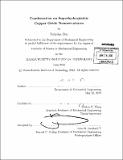Condensation on superhydrophobic copper oxide nanostructures
Author(s)
Dou, Nicholas (Nicholas Gang)
DownloadFull printable version (2.911Mb)
Other Contributors
Massachusetts Institute of Technology. Dept. of Mechanical Engineering.
Advisor
Evelyn N. Wang.
Terms of use
Metadata
Show full item recordAbstract
Condensation is an important process in many power generation and water desalination technologies. Superhydrophobic nanostructured surfaces have unique condensation properties that may enhance heat transfer through a mechanism driven by surface tension. The increased droplet removal rate and reduced size of departing droplets facilitates improvements over traditional filmwise and dropwise condensation. This work investigates copper oxide nanostructures as a potential substrate for superhydrophobic condensation. We first explored and refined a procedure for creating and functionalizing oxide nanostructures on copper surfaces. The condensation behavior of these samples was characterized using an optical microscope and an environmental scanning electron microscope by quantifying the distribution of nucleation sites and droplet growth behavior. Using the knowledge gained from these studies, an experimental test bed was designed and fabricated to measure macro-scale condensation heat transfer for flat and tubular sample geometries. Preliminary results validate previous theoretical and experimental studies of filinwise condensation and demonstrate heat transfer enhancement with dropwise condensation. The copper oxide nanostructures exhibited jumping, which shows the effectiveness of the synthesis procedure.
Description
Thesis (S.B.)--Massachusetts Institute of Technology, Dept. of Mechanical Engineering, 2012. Cataloged from PDF version of thesis. Includes bibliographical references (p. 33).
Date issued
2012Department
Massachusetts Institute of Technology. Department of Mechanical EngineeringPublisher
Massachusetts Institute of Technology
Keywords
Mechanical Engineering.